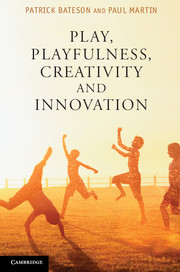Book contents
- Frontmatter
- Contents
- Advance praise
- Preface
- Acknowledgements
- 1 Introduction
- 2 The biology of play
- 3 The functions of play
- 4 Evolution and play
- 5 Creativity in humans
- 6 Animals finding novel solutions
- 7 People and organisations
- 8 Childhood play and creativity
- 9 Humour and playfulness
- 10 Dreams, drugs and creativity
- 11 Pulling the threads together
- Notes
- References
- Index
11 - Pulling the threads together
Published online by Cambridge University Press: 05 July 2013
- Frontmatter
- Contents
- Advance praise
- Preface
- Acknowledgements
- 1 Introduction
- 2 The biology of play
- 3 The functions of play
- 4 Evolution and play
- 5 Creativity in humans
- 6 Animals finding novel solutions
- 7 People and organisations
- 8 Childhood play and creativity
- 9 Humour and playfulness
- 10 Dreams, drugs and creativity
- 11 Pulling the threads together
- Notes
- References
- Index
Summary
Our purpose has been to examine whether play, and especially playful play, enhances creativity and hence innovation. At the outset we drew a distinction between playful play, in which the mood is positive, and non-playful play in which the mood is different. We have argued that play assists creativity by generating novel combinations of thoughts or actions, or by providing experience that enables the subsequent production of novel solutions to problems.
We started with an account of the research on animal play, considering its organisation, development, function and evolution. Play is defined by pointing to examples that people readily recognise. The distinction between play and serious behaviour may be communicated between players by social signals such as the ‘play-face’. Play involves novel combinations of actions or thoughts. These actions or thoughts occur outside their usual context and may be exaggerated. In social play, roles may be reversed, with the dominant individual handicapping itself. Play is typically suppressed by illness, anxiety or chronic stress and is highly sensitive to prevailing conditions. A core feature of play is its intrinsic motivation: no additional external reward is required to motivate an individual to play. Playful play is associated with a positive, light-hearted mood that facilitates divergent thinking.
- Type
- Chapter
- Information
- Play, Playfulness, Creativity and Innovation , pp. 122 - 129Publisher: Cambridge University PressPrint publication year: 2013



